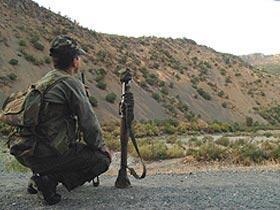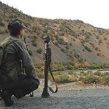
Dagestani Jamaat Expands Operations into Azerbaijan
Publication: North Caucasus Weekly Volume: 9 Issue: 44
By:

Everything started last August 17 with the explosion at the Abu Bekir mosque in Baku. This mosque is considered a meeting place for those who adhere to the Salafi ideology. A grenade was thrown into the mosque during the evening prayer, killing two people and wounding several more. (https://www.day.az/news/society/132051.html) The authorities attributed this attack to internal score-settling among the Salafists, arrested about 18 people suspected of organizing the attack, and decided to close the mosque (www.kavkaz-uzel.ru, September 2). It should be noted that the mosque was initially closed temporarily due to the investigation into the blast, but the authorities decided not to reopen it.
It is not quite clear why the Salafists themselves are accused of an attack which reflects negatively on their reputation. However, the explosion has given the authorities in Azerbaijan a pretext to close a mosque which, unlike Azerbaijan’s Muslim Spiritual Directorate, was not subservient to the state (www.kavkaz-uzel.ru, August 18). In a state where a particularly shaped beard is sufficient enough for the police to harass an individual, it is difficult to speak of the Salafis having a mass following (www.day.az/news/society/129564.html).
Starting in late August, information trickling in from the northern part of Azerbaijan, an area bordering Russia, suggested that something unusual was taking place. It subsequently became clear that measures were being taken against jamaat members, who are known in Azerbaijan as “forest brothers.” An operation to neutralize the former leader of the Dagestani Jamaat Emir Abdul-Mejid (aka Ilgar Malachiev) was carried out on August 29, while other similar measures carried out by the Azerbaijani authorities aimed at eliminating Malachiev’s group were unsuccessful (Interfax, August 29). In an operation lasting several days Azerbaijan’s military and special services tried to disarm a group of militants who had entered Azerbaijan from Dagestan. At issue here is the Lezgin ethnic minority, which after the breakup of the Soviet Union found itself divided by the Samur River between Russia and Azerbaijan. The Lezgins are the second largest ethnic group in Azerbaijan (according to various sources, they number about 250,000) (https://demoscope.ru/weekly/2004/0183/analit05.php). At the same time, according to the Russian Federation’s 2002 census, 411,000 Lezgins reside in Dagestan (https://www.perepis2002.ru/index.html?id=17).
According to information provided to the police by suspects detained during several operations aimed at disarming militant groups, on July 19th Emir Abdul-Mejid illegally crossed the border between Russia and Azerbaijan and visited Baku and Sumgait. It is likely that in the course of this trip, Abdul-Mejid attempted to form a Sumgait jamaat, which was to operate in coordination with other jamaats under the unified command of Dokku Umarov, leader of the North Caucasus Emirate. This development would mark the first time since the death of Shamil Basaev in July 2006 that an attempt has been made to form a new jamaat outside the boundaries of the North Caucasus region, thereby entangling the integral component of the Transcaucasus region—Azerbaijan.
According to the Azerbaijani authorities, the militants intend to establish not just one jamaat—in Sumgait—but to create the entire network of jamaats across Azerbaijan with particular focus on the regions bordering Dagestan. In this Lezgin-populated area of Azerbaijan jamaat members may inadvertently benefit from Baku’s negative policy towards the Lezgin ethnic minority—or, to be more precise, from the Azerbaijani authorities’ attempts to ignore the very fact of existence of this problem (https://05.moy.su/news/2006-11-24-10). It should be noted that Emir Abdul-Mejid himself hails from the Lezgin-populated area of Azerbaijan and has many influential connections there (www.kavkaz-uzel.ru/newstext/news/id/1228630.html).
All of the actions taken with regard to Emir Abdul-Mejid, including the operation to assassinate him and capture his group, tacitly confirmed that the jamaat’s zone of militant activity had expanded to that part of the Lezgin-populated territory that is under the jurisdiction of Azerbaijan. The very fact that Emir Abdul-Mejid traveled to Sumgait, a large industrial city in Azerbaijan located close to Baku, testifies to the possibility that the non-Lezgin population of Azerbaijan may be involved in the resistance movement as well. In other words, the jamaat’s territorial expansion was followed by ethnic expansion through the involvement of ethnic Azeris. At the same time, the fact that there is a relatively sizeable Lezgin Diaspora in Azerbaijan’s capital, Baku, should not be ignored either. It is conceivable that Emir Abdul-Mejid counted on Baku’s Lezgin Diaspora, because it is still premature to talk about an Azeri segment in the resistance movement’s overall structure.
It is still not quite clear how much Emir Abdul-Mejid was able to accomplish before he was killed on September 8 (RIA Novosti, September 9). Right after his death, the jamaat withstood another devastating strike when about 10 of its members were killed while illegally crossing the border from Azerbaijan to Dagestan (www.ng.ru/cis/2008-09-23/6_azerbaidzhan.html). The coordinated action taken by Russian and Azerbaijani Special Forces indicates that this operation was planned well in advance and not spontaneous.
A week after the assassination of Emir Abdul-Mejid, a news report appeared about another special operation against the members of the “forest brothers” in the northern regions of Azerbaijan (APA News Agency, September 19).
On October 2, the Azerbaijani authorities announced they had arrested 25 members of the “forest brothers” group, which possibly implied that they were jamaat members (https://www.day.az/news/society/132051.html).
On November 10, Azeri news media reported that the Azerbaijani authorities were conducting special operations against jamaat members in the Lezgin-populated northern part of the country (https://yerkramas.org/news/2008-11-10-1805).
This means the Azerbaijani authorities failed to deprive the jamaat members of their sanctuary in the northern part of the republic in August and September. It can be surmised from this that there is a well-formed and deeply rooted jamaat in that part of the country that continues to function even after the death of its leader Emir Abdul-Mejid. The absence of news reports about actions carried out by the jamaat of Lezgins of Azerbaijan on the website controlled by prominent North Caucasian Salafist ideologue and political figure Movladi Udugov, who also happens to be responsible for informational support of the Caucasus Emirate, is possibly related to the fact that full-fledged contacts between the aforementioned jamaat and the structures of the Emirate have not yet been established. In other words, after organizing this entity in that area of Caucasus, Emir Abdul-Mejid simply did not have time to connect it with his contacts abroad and within the Caucasian Emirate.
The network of jamaats operating in the Caucuses has grown and now incorporates cells from Sochi in the northwest to Baku in the southeast. However, it is important to emphasize that this growth does not imply an overall radicalization of the region or that there will be any such development in the foreseeable future. The portion of the region’s population who are ready to carry out armed resistance is below one tenth of one percent. However, this tiny minority is far more active in its expression of dissent than the passive majority is in its expression of support for the Russian or the Azeri regime. Their main achievement is that they have a shared ideology (Salafism), a shared objective (assuming power in the region), and the means of achieving it through armed struggle and attrition warfare that will eventually force the Russian army out of the region.




